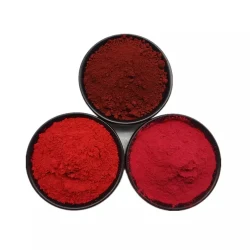Types of inorganic pigments
2023-11-13
Inorganic pigments are colorants that are derived from mineral compounds and are typically not based on carbon-containing compounds. These pigments are widely used in various industries, including paints, coatings, plastics, ceramics, construction materials, and printing inks. Unlike organic pigments, which are carbon-based and often derived from petroleum, inorganic pigments are generally mineral-based. Here are some common types of inorganic pigments:
1. Titanium Dioxide (TiO2):
- Color: White
- Properties: Widely used as a white pigment due to its excellent opacity, brightness, and UV-reflective properties. It is a key component in white paints, coatings, plastics, and paper.
2. Iron Oxides:
- Colors: Red, yellow, brown, and black
- Properties: Iron oxide pigments are derived from iron ore and are used to produce a range of colors. Red and yellow iron oxides are common in paints, coatings, and construction materials, while black iron oxide is used in black and brown pigments.
3. Carbon Black:
- Color: Black
- Properties: Carbon black is produced by incomplete combustion of hydrocarbons. It is widely used as a black pigment in inks, paints, plastics, and rubber products. It provides intense black color and UV protection.
4. Chromium Oxide Greens:
- Color: Green
- Properties: Chromium oxide greens are stable, heat-resistant pigments used in paints, plastics, and ceramics. They provide durable green coloration and are often used in camouflage coatings.
5. Ultramarine Pigments:
- Colors: Blue, pink, green
- Properties: Derived from minerals such as lapis lazuli, ultramarine pigments are used in a range of colors. Synthetic ultramarines are widely used as blue pigments in paints, plastics, and cosmetics.
6. Cadmium Pigments:
- Colors: Yellow, orange, red
- Properties: Cadmium pigments offer vibrant and stable colors. However, due to environmental concerns related to cadmium, there has been a shift towards alternative pigments in some applications.
7. Lead Chromate Pigments:
- Colors: Yellow, orange
- Properties: Lead chromate pigments offer bright and opaque colors. However, like cadmium, the use of lead-based pigments has declined due to environmental and health considerations.
8. Zinc Oxide:
- Color: White
- Properties: Besides its use as a pigment, zinc oxide is also utilized as a multifunctional material in sunscreen, ointments, and rubber manufacturing.
9. Manganese Dioxide:
- Color: Brown, black
- Properties: Manganese dioxide is used as a brown or black pigment in ceramics, paints, and inks.
10. Antimony Trioxide:
- Color: White
- Properties: Antimony trioxide is used as a flame retardant and opacifying agent in various applications, including plastics and textiles.
Inorganic pigments are valued for their durability, resistance to environmental conditions, and stability under various manufacturing processes. However, considerations for safety and environmental impact have led to the development and increased use of alternative pigments in certain applications. As with any pigments, it's important to follow proper handling and disposal guidelines to minimize environmental impact and ensure worker safety.



